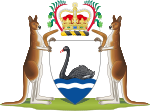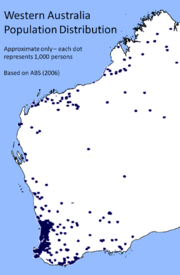Western Australia
| flag | coat of arms |
|---|---|

|

|
| ( Details ) | ( Details ) |
| Basic data | |
| Capital : | Perth |
| Area : | 2,529,880 km² |
| Residents : | 2,584,800 (Dec 2017) |
| Population density : | 1.02 inhabitants per km² |
| ISO 3166-2 : | AU-WA |
| Time zone : | AWST ( UTC + 8 ) |
| The highest point: | Mount Meharry 1,251 m AHD |
| Official Website: | www.wa.gov.au |
| politics | |
| Governor : | Kim Beazley |
| Prime Minister : | Mark McGowan ( laboratory ) |
| Parliament seats: | 15 ( House of Representatives ) 12 ( Senate ) |
| map | |
Western Australia [ ˈwestən ɒˈstreɪliə ] ( German West Australia , abbreviation: WA ) is an Australian federal state. Its capital is Perth . Western Australia is very sparsely populated.
geography
The state of Western Australia is located west of the meridian 129 ° E.
It is divided from north to south into the diverse Kimberley Plateau with the Bungle Bungles , the Great Sand Desert , the Hamersley Range (1235 meters), the western part of the Great Victoria Desert and the Nullarbor Desert . The dominant landscape are the uniform hull lands of the Australian shield. But there are also interesting geological formations such as the undulating Wave Rock , the China Wall at Halls Creek or the Pinnacles , free-standing limestone columns.
Western Australia can be divided into ten regions by geological classification: Perth with Fremantle , Peel , South West , Great Southern , Goldfields-Esperance , Wheatbelt , Mid West , Gascoyne-Outback Coast , Pilbara and Kimberley . The total land area of Western Australia is 2,529,880 km², which is seven times the size of Germany.
The Gascoyne Outback Coast region of Western Australia is home to the group of the oldest life forms found so far, the stromatolites , which have been around for nearly 3.5 billion years. It is one of the few places where they still exist. You are in Hamelin at Shark Bay , as UNESCO - World Heritage listed.
population
Around 1.7 million people in Western Australia live in the Perth metropolitan area with Perth and Fremantle . Most of the remaining 800,000 inhabitants are concentrated in the relatively small part around the south-western tip of Australia. The second largest city in Western Australia is Bunbury with 64,000 inhabitants (175 kilometers south of Perth).
Population development
| Census year | population |
|---|---|
| 1996 | 1,705,949 |
| 2001 | 1,828,294 |
| 2006 | 1,959,085 |
| 2011 | 2,239,170 |
| 2016 | 2,474,410 |
climate
In the north there is a tropical and hot monsoon climate , in the southwest a warm, moderate winter rain climate , in the inland and in the southeast there is a large area with a hot summer and a cool arid dry climate . Summer (from December to March) brings heavy rainfall and oppressive humidity in the north, while temperatures well above 40 ° C can be tolerated in the interior. Only the coast is then cooled by sea winds in the evening, for example the capital Perth by the so-called Fremantle Doctor . Perth enjoys a pleasant Mediterranean climate with long, hot summer months (December to February) and mild, cooler winter months (June to August) and, with an average of eight hours per day, more sunshine than any other Australian city.
economy

The main industry of the state is mining or individual prospecting for natural resources. Over 90% of Australian ore production comes from Western Australia. These are in particular metal ores such as iron ore , uranium , nickel , tin ore and gold in addition to other minerals such as bauxite or coltan . Is of energy resources of coal , oil and natural gas promoted, where since 2009 the world's largest gas liquefaction plant in the Gorgon gas project arises that in 2014 eight percent of the world's production of liquefied natural gas will supply. The extraction of gemstones mainly yields diamonds .
Large areas of Western Australia can only be used as pastureland for sheep because of the dry and hot climate , other types of agriculture are cattle and pigs in arable areas as well as the cultivation of fruit , grain , potatoes and wine . Two-thirds of Australia's wheat production comes from the Western Australian Heartlands.
The manufacturing industry is concentrated in the Perth area, around 75 percent of the population lives there, in 1998 just under 1.86 million people. Because of the diversity of the landscape and the interesting flora and fauna, tourism is gradually starting to play a certain role. B. Rottnest Island or the tame dolphins of Monkey Mia in Shark Bay , or the diving paradise on Ningaloo Reef . On the Laceped Islands there are important breeding areas for sea birds and sea turtles , which are also visited by tourists.
history
The area was settled by Aboriginal people about 40,000 years ago , which include the Noongar and Spinifex People .
The west coast was first reached by Europeans in 1616 by the Dutchman Dirk Hartog near Shark Bay . By the end of the 17th century, other seafarers (including Abel Tasman and Willem de Vlamingh ) had then explored the entire coastline on behalf of the Dutch East India Company . However, one could not do business with the Aborigines encountered and lost interest in the area.
The first unofficial settlement attempt was made in 1826 by the British in the area of what is now Albany . In 1827 Captain James Stirling returned from an expedition and gave the British King a much more positive report of the Swan River area . Not least in order to forestall attempts to colonize other nations, he was commissioned to found a new colony.
In April 1829, Captain Charles Fremantle landed at the mouth of the river with his ship Challenger , followed by Captain James Stirling with his ship Parmelia in May . There they founded the Swan River Colony , named after the black swans that can be found here in large numbers. It later became Western Australia. In doing so, they displaced the indigenous people, the Aborigines.

In contrast to the eastern colonies of Australia, colonization here initially took place according to the theoretical ideas of the British economist Edward Gibbon Wakefield without the participation of prisoners. This continued Thomas Peel order without the use of public capital, which meant that the colonization threatened to collapse. The lack of manpower and other economic problems nevertheless meant that between 1850 and 1868 around 10,000 convicts were used for the construction of public facilities.
Three settlements served as the nucleus of what would later become Western Australia:
- the port of Fremantle directly at the river mouth (named after the first captain),
- the "place of residence" Perth about 20 kilometers upstream on a lake-shaped extension of the river (named in honor of Captain Fremantle's father-in-law, Sir Charles Murray (MP from Perth in Scotland)) and
- a further 20 kilometers upstream - as far as the ships could go - then Guildford (named after Captain Stirling's father-in-law, who was a member of Guildford in Surrey) as the gateway to the fertile Swan Valley , which should ensure the supply of the colony. Captain James Stirling himself became the new colony's first governor.
The mineral wealth in Western Australia led to the establishment of the Geological Survey of Western Australia in the 1880s . The Coolgardie gold rush occurred in the 1890s . This gold rush drew numerous prospectors to the sparsely populated Western Australia and the population grew. In 1901 Western Australia became a founding member of the newly formed Australian Federation.
After Western Australia joined the Australian Confederation, there was considerable dissatisfaction in Western Australia with the customs policy pursued by the federal government. The protectionist policy disadvantaged agriculture in Western Australia in particular. The problems were exacerbated by the Great Depression from 1929 and resulted in a massive secession movement in Western Australia. In a referendum on the secession of Western Australia in 1933 , a clear majority of voters voted in favor of leaving the Australian Confederation. This did not take place, however, as both the Australian government and the British government rejected it.
After the Second World War , the population of European descent came to a certain degree of prosperity, while many Aborigines still live in poor conditions on reservations today.
Universities
- Curtin University of Technology (CURTIN), Perth
- Edith Cowan University (ECU), Perth
- Murdoch University (MURDOCH), Perth
- University of Notre Dame Australia (UNDA), Fremantle
- University of Western Australia (UWA), Perth- Crawley
See also
Web links
- Western Australian Tourist Office (English)
- Western Australian Tourist Office
- Western Australian government website
Individual evidence
- ↑ 3101.0 - Australian Demographic Statistics, Sep 2014 , accessed June 16, 2015.
- ↑ Already 3.5 billion years ago, microorganisms populated the oceans of the planet: When the earth came to life. In: Berliner Zeitung. Retrieved December 28, 2015 .
- ^ Dresser Formation ( Memento from September 27, 2007 in the Internet Archive )
- ↑ Australia: Administrative Division (Census) (States and Local Government Areas) - Population Statistics, Charts and Map. Retrieved September 5, 2018 .



